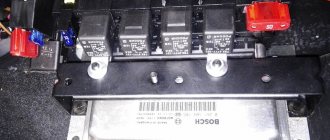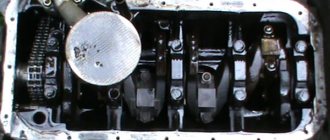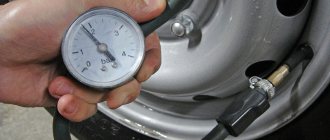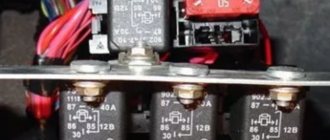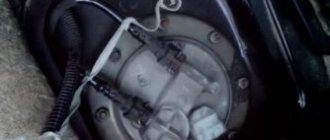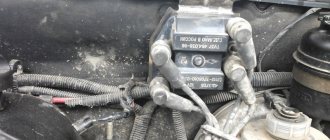02 October 2020 Lada.Online 12 720 12
Weaknesses and typical problems are identified during the operation of any car, the Chevrolet Niva (and now Lada Niva) is no exception. There is such an SUV in the editorial park of the Za Rulem magazine. Over the 7 years of its operation, experts have studied all the problems and weaknesses of this car. When choosing a used Niva, pay attention to these points.
Maintenance and repair of Chevrolet Niva (Chevrolet Niva)
Initially, for the Chevy Niva, which is an off-road vehicle, the designers used a 1.7 liter gasoline engine. It is well known for the VAZ-2123 and VAZ-21214 models. It has distributed fuel injection, produces about 80 horsepower, and is paired with a 5-speed manual transmission. The car uses permanent all-wheel drive, which is implemented using a center differential lock. Other technical characteristics depend on when the Chevy Niva was released - before or after restyling. It is noteworthy that a limited number of cars with the FAM1 index were equipped with a 1.8-liter Z18XE engine from Opel.
THE ENGINE TAKES A LONG TIME TO WARM UP TO OPERATING TEMPERATURE
| List of possible faults | Diagnostics | Elimination methods |
| Thermostat is faulty | Check that the thermostat is working properly | Replace the faulty thermostat |
| Low air temperature (below –15 °C) | — | Insulate the engine: cover the slot on the front bumper with windproof material |
Specifications
Technical parameters of Chevrolet Niva (2123) 1.7 / Chevrolet Niva (2123) in a 5-door body. SUV with an 80 hp engine, 5 manual transmission, produced from 2002 to 2009.
Basic data
- Start of production:
January 2002 - End of production:
January 2009
- Body:
5 doors SUV
Engine
- Engine capacity, cubic meters see: 1690
- Valves per cylinder: 2
- Supercharging: no
- Power, hp: 80
- Achieved at vol. per minute: 5200
- Torque, Nm/rev. per minute: 127/4000
- Maximum speed, km/h: 140
- Acceleration time to 100 km/h, sec.: 19
- Engine layout: front, longitudinal
- Power system: distributed fuel injection
Drive unit
- Drive type: full
Transmission
- Transmission: Manual
- Number of steps: 5
Suspension
- Front: independent
- Rear: Dependent
Brakes
- Front: disc
- Rear: drum
Dimensions
- Length, mm: 4048
- Width, mm: 1770
- Height, mm: 1652
- Wheelbase, mm: 2450
- Front wheel track, mm: 1450
- Rear wheel track, mm: 1440
Chevy Niva engine malfunctions
Among the Chevy Niva engine breakdowns are:
- Loss of power, deterioration of throttle response.
- Excessive noise.
- Increased gasoline consumption.
- Binge on butter.
- Interruptions in engine operation.
Often these signs indicate natural wear and tear on the working surfaces, rather than critical breakdowns. If this is confirmed by comprehensive diagnostics, it makes sense to use RVS-Master for in-place restoration of the power unit. For a standard Chevy Niva with a 1.7 liter engine, which requires 3.75 liters of oil for lubrication, the Ga4 composition is suitable. It restores worn components and strengthens contact surfaces by building up a layer of metal-ceramics. Thanks to the treatment, compression is normalized, the amount of noise and vibration is reduced, consumption drops, and starting is simplified at sub-zero temperatures.
The friction geomodifier restores compression when cylinders and piston rings wear out. But the composition will not help if there is a breakdown in the cylinder head gasket or the pistons have already burned out.
Interruptions in the operation of the Chevrolet Niva engine
/ Chevrolet/ chevrolet-niva/ Malfunctions on the way/ Interruptions in engine operation
During interruptions, the engine idles unevenly, does not develop sufficient power, and consumes gasoline increased. Interruptions, as a rule, are explained by a malfunction of the injectors or electric fuel pump (for more details, see “Engine Management System”), a malfunction of the spark plug of one of the cylinders, or air leaks into one of the cylinders. It is necessary to find the fault and, if possible, eliminate it.
| 1. Start the engine and let it idle. Go to the exhaust pipe and listen to the sound of the exhaust. You can bring your hand to the cut of the exhaust pipe - this way the interruptions are felt better. The sound should be even, “soft”, of the same tone. Popping noises from the exhaust pipe at regular intervals indicate that one cylinder is not working due to a failed spark plug, lack of a spark, an injector failure, a strong air leak into one cylinder or a significant decrease in compression in it. Popping noises occur at irregular intervals due to dirty injector nozzles, severe wear or dirty spark plugs. If popping noises occur at irregular intervals, you can try to replace the entire set of spark plugs yourself, regardless of mileage and appearance, but it is better to do this after contacting a car service center to diagnose and repair the engine management system. | 2. If the popping sounds are regular, stop the engine and open the hood . Check the condition of the ignition system wires. High-voltage wires must not have insulation damage, and their tips must not be oxidized. If there is damage to the wires, replace the faulty wire. |
| 3. Remove the ends of the high-voltage wires... | 4. ...and turn out the spark plugs with a spark plug wrench. |
| WARNING When removing high-voltage wire lugs, never pull on the wire itself. Place your hand directly on the tip and twist it from side to side and then pull before removing it. |
Carefully inspect the candles and compare their appearance with the photographs given at the end of the subsection. The gap between the spark plug electrodes should be 0.8–0.9 mm. If the candle is black and wet, you can throw it away.
| 5. If all the spark plugs look good, reinstall them and connect the high-voltage wires. The operating order of the cylinders is 1–3–4–2, the numbering of the cylinders (1, 2, 3, 4th) is done from the engine crankshaft pulley. |
| 6. Take a spare spark plug. Secure it to the engine in any way. |
| WARNING Do not fix the spark plug to the oil filler neck, oil dipstick, or fuel hoses. |
Reliable contact of the body or threaded part of the spark plug with the “ground” is optional, but desirable. Connect the high-voltage wire from cylinder 1 to the spare spark plug. Start the engine. If engine interruptions do not worsen, replace the spark plug in cylinder 1 with a known good one. Attach the high voltage wire and start the engine. If the interruptions intensify, repeat procedure step 6 sequentially with all cylinders to identify the faulty spark plug.
If, as a result of the measures taken, engine interruptions are not eliminated, contact a car service to diagnose the ignition system on a stand or diagnose the engine - measure the compression. Normal compression – more than 1.1 MPa (11 kgf/cm 2
), a difference of more than 0.1 MPa (1 kgf/cm
2
) in one cylinder indicates the need for engine repair.
| USEFUL TIPS If the diagnosis reveals a malfunction of the 3rd cylinder, remove the hose connecting |
If interruptions in engine operation have ceased, diagnostics and replacement of the vacuum brake booster is required (see section 8 “Brake system” ).
If engine trouble continues, try spraying a liquid like WD-40 on the outside of the hose. If engine interruptions stop even for a short period of time, try replacing the hose - there may be a rupture in it.
Diagnostics of the engine condition by the appearance of the spark plugs
| 1. Normal candle. |
Brown or grayish-yellowish color and slight wear on the electrodes. Accurate thermal value for engine and operating conditions.
| HELPFUL ADVICE When replacing spark plugs with new ones, install spark plugs with the same characteristics. |
| 2. Soot deposits. |
Dry soot deposits indicate a rich air/fuel mixture or late ignition. Causes misfire, difficult engine starting and unstable engine operation. Check if the air filter is clogged and if the coolant and incoming air temperature sensors are working properly.
| HELPFUL ADVICE Use a “hotter” spark plug (extended insulator with a central electrode). |
| 3. Oil deposits. |
Oily electrodes and spark plug insulator. The reason is oil getting into the combustion chamber. Oil enters the combustion chamber through valve guides or piston rings. Causes difficult starting, cylinder misfires and jerking of the running engine. The cylinder head and piston group of the engine need to be repaired. Replace spark plugs.
| 4. Overheating. |
The reasons may be: the type of spark plug does not match the one recommended for your car’s engine, early ignition, lean mixture, air leaks into the intake manifold. Check the coolant level and whether the radiator is clogged.
| 5. Early ignition. |
Melted electrodes. The insulator is white, but may be contaminated due to missed sparks and deposits from the combustion chamber falling on it. May cause engine damage. It is necessary to check the correct type of spark plug, serviceability of the knock sensor, cleanliness of the injector nozzles and fuel filter, operation of the cooling and lubrication systems.
| 6. Glaze. |
The insulator is yellowish, covered with glaze. Indicates that the temperature in the combustion chamber suddenly rises during sudden acceleration of the vehicle. Normal deposits become conductive. Causes misfires at high speeds.
| HELPFUL ADVICE After installing new spark plugs, change your driving style. If you don't want to do this, try installing cooler spark plugs. |
| 7. Bridge between electrodes. |
Deposits from the combustion chamber fall between the electrodes. “Heavy” deposits collect in the gap between the electrodes and form a bridge. The spark plug stops working and the cylinder stops working. Identify the faulty spark plug and remove deposits between the electrodes.
| 8. Ash deposits. |
Light brown deposits crusting over the center and side electrodes. Isolated from additives to oil or gasoline. A large number of them can lead to insulation of the spark plug electrodes, causing misfires and interruptions during acceleration. If excessive deposits form over a short period of time or low mileage, replace the valve guide seals to prevent oil from entering the combustion chamber.
| USEFUL ADVICE If deposits consistently form over a long mileage, the reason is the quality of gasoline - change the refueling location. |
| 9. Wear. |
Rounded electrodes with a small amount of deposits on the working ends. Normal color. Causes difficult starting in cold or wet weather and poor fuel economy. Replace the spark plugs with new ones of the same specifications.
| 10. Detonation. |
The insulator may be cracked or chipped. This may damage the piston. Make sure that the octane number of gasoline matches the required one. Check the serviceability of the knock sensor.
| 11. Spotted deposits. |
After proper adjustment, carbon deposits deposited in the combustion chamber begin to burn out and, at high engine speeds, come off the piston and stick to the spark plug insulator, causing occasional misfires in its operation. Replace the spark plugs with new ones or clean the old ones.
| 12. Mechanical damage. |
Damage can be caused by foreign objects getting into the combustion chamber, and if you use a spark plug that is too long, its electrodes can catch on the piston. This causes spark plug destruction, cylinder shutdown and can damage the piston. Remove the foreign object from the cylinder and/or replace the spark plug.
Comments
No comments yet
Leave a comment Cancel reply
Transmission (gearbox and axle)
Problems with the mechanical part of the manual transmission are manifested by increased noise, difficulties when switching, and unclear gear shifting. Often the cause of the above-mentioned defects lies in the wear of synchronizers and gear teeth. Less commonly observed are violations of clutch adjustments, a banal decrease in oil level, and wear of other gearbox elements.
RVS-Master Transmission Tr3 will help normalize the operation of the Chevy Niva manual transmission. The friction geomodifier will restore the geometry of the gears, compensate for wear on the gears, and increase the service life of individual components. The composition is designed for 3 liters of oil in a box, and since the Chevrolet Niva gearbox has only 1.6 liters, the remainder can be used for treating axles. Their malfunctions and wear are manifested by increased noise and knocking at the moment of starting movement. Thanks to treatment with the RVS composition, it is possible to restore the bearings and gears of the gearbox, which will eliminate the characteristic noise when driving.
Weaknesses and malfunctions of the Chevrolet Niva
On the Internet you can find many “terrible” descriptions of problems and breakdowns of the Chevrolet Niva. For example, that already at 50,000 km, problems with the timing chain may begin, the starter may fail, the clutch will burn out, the transfer case will “snot”, through metal corrosion will begin, and so on. But in practice, as we see, you can find a huge number of Shnivas on the roads and in pretty good condition, and there is also considerable demand for the car aftermarket. And would people buy a “bucket of bolts” that needs to be constantly repaired and invest their hard-earned money into it? I think no. The Chevy Niva is actually a good SUV, and many problems about it are simply made up and exaggerated many times over.
Here I will describe what you should check before purchasing, what you should pay attention to, and what problems may arise. After all, you see, the same car can be in completely different states, depending on its owner and operating conditions.
Also interesting: How to start a Niva if the battery is dead (5 ways)
1) Corrosion. This is a really common disease of Shniv bodies, since only a part of the parts were galvanized at the factory, and even then of poor quality. Rust, even in 5-6 year old cars, can be found in the area of chips - hood, fenders, side members. And the most problematic places remain the rear wings and arches.
Therefore, it is recommended to carry out additional anti-corrosion treatment for this vehicle. And it’s very cool if you come across such a copy, the previous owner of which has already treated the body with anticorrosive and installed fender liners.
2) Timing chain. On the Internet you can find stories where the chain jumped already at 60-80 thousand kilometers and had to be changed. In practice, this disease does not occur on every car, but this cannot be denied. Therefore, it is necessary to periodically monitor the condition of the chain, and usually replacing the chain tensioner and pump solves this problem.
For example, a friend’s Chevy Niva already has 110,000 km on it, and he hasn’t done anything to the chain. Everything works fine. But he says that with a mileage of about 150,000 km it will be necessary to change the chain, tensioner, and pump. And also change the hydraulic compensators.
When inspecting, listen to see if there are any extraneous noises in the engine operation.
3) Brake pads fail quite quickly. But this is a consumable material, especially since it is worth considering that this car is usually often used in off-road conditions - sand, water, all this quickly corrodes the pads.
4) When inspecting, check to see if the axle gearbox and transfer case are leaking. There is such a disease on Shnivy, but this nuance, again, does not occur on every car and may not appear until 150,000 km.
And it is also important that the transfer case and transfer case do not make too much noise when driving, otherwise you may end up having to completely replace these components. Or it will be enough to replace the clutch or the release bearing itself. A little noise is quite acceptable, because they cannot work absolutely without noise.
5) The factory 80-amp generator KZATE-80A lasts quite a long time, although some write that it fails even before 100,000 km. Some people change it to a more powerful one, for example, the 100-120 ampere KZATE-120A. But you shouldn’t touch it if there are no problems. In addition, you can go to an auto electrician and resolve the issue without a complete replacement.
6) As for shock absorber bushings, hubs, oil seals, silent blocks, bearings, their serviceability will depend on how and where the owner drove. If you didn’t skimp on the off-road, jumped on the pits, then of course the parts will wear out quickly, and if you moved at a moderate pace and treated them with care, then they will last about 80-100 or more thousand kilometers.
Ball joints have to be changed every 35-40 thousand km.
7) Expansion tanks on Nivas have a short lifespan, and in 80-100 thousand km you can change them three times.
 The starter usually dies after 90,000 km, some earlier, some later. The cost of a good starter is 2500-3000 rubles.
The starter usually dies after 90,000 km, some earlier, some later. The cost of a good starter is 2500-3000 rubles.
9) The interior, naturally, does not feature super-high-quality finishing materials, and there is plenty of noise in it, but for the money it is quite tolerable. The weak point is the steering wheel upholstery, which peels off after 30,000 km. The solution is to install an overlay.
To summarize, I will say what is obvious to me. Chevy Niva is a decent SUV, more comfortable and roomy compared to the VAZ Niva. However, when buying it, you should understand that you will have to invest, but how much depends on the specific option. I meant a used car. I'm not saying anything about the new one. So when buying, inspect everything thoroughly, go to the service center, go to the lift, listen to the internal combustion engine, gearbox, manual transmission and everything else.
Corrosion - 2003 model. Usually, when a car has fender flaps, it is a sign that they are hiding rust.
Valve train chain
Chevrolet Niva transfer case leaking
The tank burst - usually due to temperature changes
covered the steering wheel
Injector
In the Chevy Niva, a nozzle is responsible for regulating and supplying fuel to the combustion chamber, the operation of which is “managed” by the electronic engine control system. Due to low quality fuel and untimely replacement of filters, the injectors become clogged, which disrupts the atomization of gasoline and reduces the performance of the injectors. This is fraught with an imbalance in the operation of the engine, increased consumption, and a decrease in the throttle response of the power unit. And all because the heavy fractions of gasoline settle on the internal surfaces and become coked. Due to carbon deposits and contamination, the functioning of the injectors is completely disrupted. Flushing the RVS-Master Ic injector helps get rid of problems. This composition has a complex effect on the injector, fuel pump, engine:
- Abrasive particles damage the metal elements of the pump, which causes corrosion. RVS-Master cleans work surfaces and then forms a protective layer of cermet on them.
- The internal surfaces of the injectors are cleaned of carbon deposits and other fuel breakdown products. The same thing happens with the fuel path.
- The composition partially enters the combustion chamber, where it helps restore the upper edge.
Source
Advantages of the Chevrolet Niva over other jeeps
Chevrolet Niva is a unique symbiosis of the Soviet Niva car and high-quality American technology. Its design skillfully combines Russian assertiveness and foreign compactness. Despite the fact that American SUVs do not have average dimensions, the technical characteristics of the Chevrolet Niva fit perfectly into a small body.
For some time, debates continued all over the world about who to take the Niva for - a small jeep or an overly large crossover. The answer is simple - at the time of development and release of this car, the segment called “crossover” did not even exist. It was just beginning to emerge, releasing the first experimental models, which included the Jeep Wrangler, Toyota 4Runner, Jeep Grand Cherokee, BMW X5 and others.
Today, the main competitors of the Niva Chevrolet are Hyundai Tucson, Kia Sportage, Kia Sorento and Ssang Yong. They all have approximately the same technical characteristics, but the Chevrolet Niva has a number of advantages, which are contained not only in the engine compartment, but also in the design and interior of the cabin.
The advantage of the Chevrolet Niva becomes obvious immediately after the first test in difficult road conditions. Its owners speak highly of it, saying it will stick where many others won't. And this is actually true, because unlike the previously mentioned models, the Chevrolet Niva (or as its owners call it, Shniva) has a high seating position, which allows it to overcome fairly deep ruts and potholes.
The Chevrolet Niva has a solid capacity, which was achieved by increasing the length of the wheelbase, therefore, in addition to five people, this car will be able to transport large cargo in the luggage compartment, the volume of which is 320 liters. For comparison, the volume of the same compartment in the Hyundai Tucson is 295 liters.
The difference is small, but sensitive. According to owner reviews, the basic equipment of the Chevrolet Niva is simply excellent. It includes an adjustable steering column, reliable power steering, central locking, heated side mirrors and a good sound system. Of course, other manufacturers also stuff their “brainchildren” with similar bells and whistles, but the Chevrolet Niva is a car proven by time, harsh conditions and a large number of demanding drivers.
The advantage of the Chevrolet Niva is obvious - its great popularity speaks for itself. The fact that more than 4 million copies were sold in Russia directly shows that this car has become a people's favorite and is preferred to many other SUV models that do not have the necessary potential or do not suit the owners in terms of configuration.
What causes a malfunction of Chevrolet Niva injectors, tips on selection, flushing and replacement
The Chevrolet Niva, like most modern cars, is equipped with an injection engine with a fuel injection system.
Electromagnetic injectors are the key elements of this system. They spray the required amount of gasoline, forming an air-fuel mixture that enters the combustion chambers. The valves built into the injectors open upon command from the engine ECU.
This allows you to dose the fuel supply to the cylinders. If malfunctions occur, engine operating parameters deteriorate. In case of serious problems, the engine starts to stall or stops starting altogether.
Chevrolet Niva engine tuning
Before carrying out various actions on your car and changing its appearance, you should pay attention to the power unit. The engine undergoes tuning much more often than any other parts. Thanks to this operation, engine power can be significantly increased. You will achieve this result if you replace the factory pistons and camshaft in time. In addition, it is recommended to modify the gas distribution mechanism together with the valve system, as well as install a balanced flywheel.
Also interesting: Advantages of a diesel Niva Chevrolet and what engine can be installed
When changing all these spare parts, you should know when to stop. Some motorists replace the standard engine with a unit with a displacement of 5 liters. Experts believe that such an off-road vehicle burns a lot of fuel and also causes discomfort when driving.
Many have come to the conclusion that it is better to use a standard internal combustion engine, the working volume of which is up to 17,000 cubic cm. This is a fairly noticeable increase in power. This result can be achieved by replacing the pistons. When choosing these parts, you should choose products with a large diameter. Typically, tuned pistons are classified into two types: forged and cast.
A product made of reliable and durable material increases the service life of the pistons. However, experts refer to the fact to keep every detail in balance. If the center of gravity shifts relative to the piston pin axis, this can lead to tilt. At the same time, the walls are damaged much faster, compression decreases, etc. When choosing pistons for a Chevrolet Niva, you need to be careful.
More optimized ventilation of the Shevi Niva combustion chamber is achieved thanks to tuned valves that are T-shaped. If you properly treat the locking surface of tuned valves, you can achieve excellent sealing of the cylinder. With the help of the low mass of the plate, the specified temperature regime of the valve is maintained. It is important to note that the T-shaped valve almost never burns out.
An upgraded camshaft for tuning can be classified into three categories. Tuning the Chevrolet Niva engine will make you feel as safe as possible when driving off-road. In addition, it is important to maintain the driving pace if a lower gear is engaged. For this purpose, you will have to select the appropriate camshaft.
Important! Manufacturers produce various modifications of tuning shafts for Chevrolet Niva SUVs. Therefore, they have to be numbered in order to select the appropriate model.
When choosing a tuning kit for a gas distribution mechanism, pay attention to the availability of software firmware. Thus, in the future the Chevrolet Niva engine will operate correctly. You can contact a car service center where turbines will be installed.
Symptoms of a problem
Contamination of the channel or malfunction of the solenoid valve is manifested as follows:
- The engine starts poorly and runs unstably.
- Increased or decreased idle speeds are observed, the engine may stall when the gas pedal is released.
- Power deteriorates.
- Acceptance decreases.
- Fuel consumption is increasing.
- The content of harmful substances in exhaust gases increases.
- Black smoke appears from the exhaust pipe.
- Glow ignition is observed (if the valve is not completely closed).
Important: the listed symptoms also occur for other reasons. Therefore, before you start cleaning or replacing injectors, they should be checked.
Examination
The operation of the solenoid valve can be checked without removing parts from the machine. For this you will need a multimeter.
The check is performed as follows:
- Remove the wires from the connectors on the injectors.
- Turn on the multimeter in ohmmeter mode.
- Check the resistance at the terminals.
The solenoid valve winding has a resistance of 11-15 ohms. If the device readings differ from the nominal values, the parts must be replaced.
Important: this method does not reveal whether the jets are clogged or incompletely closed. Therefore, for a comprehensive check you will have to remove it from the engine.
To diagnose the operation of injection parts, special equipment is required. Therefore, a full check can only be performed at a service station. To diagnose at home, you must perform the following steps:
Chevrolet Niva injection repair
Injectors can be washed on a bench or using a fuel additive. However, at home this operation is performed using a syringe. To do this, you will have to first remove the parts.
For dismantling you will need the following tools:
- Two keys for 17.
- Hexagon 5.
- Keys for 10 and 13.
- Screwdriver.
- Coolant container (1-2 l).
Removing the injectors is done as follows:
- Disconnect the air supply hose to the throttle body.
- Remove the end of the damper drive cable.
- Unscrew the nuts securing the throttle assembly and move it to the side.
- Using a 10mm wrench, unscrew the cable fastening to the receiver.
- Move the bracket aside.
- Loosen the fastening clamp and remove the vacuum booster hose from the receiver fitting.
- Unscrew the purge valve and move it to the side.
- Using a 13mm socket, unscrew the nuts (two on top and three on bottom) holding the receiver in place.
- Remove the engine screen mounting bracket.
- Remove the receiver.
- Place a container and drain 1 liter of coolant.
- Loosen the clamp and remove the pipe leading to the heater radiator from the cylinder head fitting.
- Unscrew the screw and remove the fuel line pipe clamp.
- Unplug the engine harness wire connector.
- Remove the two mounting screws and remove the fuel rail.
- Disconnect the wire connectors from the injectors.
Attention: when completely removing the ramp from the engine, you need to loosen the clamp and disconnect the fuel line tube.
- Remove the injector retainer and remove it from the ramp.
Assembly of the unit is carried out in the reverse order. When installing new parts, the O-rings should be replaced. After completing the work, it is necessary to pour the coolant from the container into the expansion tank.
Engine
The all-terrain vehicle is equipped with a 1.7 liter (80 hp) gasoline engine with a timing chain drive. The design of the standard timing belt tensioner is not reliable enough - it allows the chains to jump. After starting a cold engine, the hydraulic chain tensioner (HNC) often rattles until the engine warms up. The weak points of the tensioner are the unreliable design of the aluminum oil supply tube and check valve. Replacing the GNC may be necessary after 50,000 km. A good alternative to a standard tensioner can be an analogue that has a longer service life. The chain stretches after a mileage of more than 100,000 km.
Niva VAZ – 2123 1998 – 2002
If the engine immediately stalls after being parked for a long time, then most likely you will need to replace the throttle position sensor (TPS, 300 rubles). This can happen already with a mileage of just over 10 thousand km. Replacing high-voltage wires may be necessary when the mileage is more than 60 - 80 thousand km. At around 80-90 thousand km, valve burnout occurs. And the rear crankshaft oil seal begins to “snotty” after 100 thousand km. If, after a mileage of more than 100 - 120 thousand km, the traction is lost and the engine starts to stall, then the ignition module may have come to an end.
With the same mileage, a knocking sound from the hydraulic compensators may occur. This can lead to breaking of the thread for the hydraulic compensator, destruction of the ramp and burning of the valves, which in turn will reduce compression in the cylinders. To avoid illness, car service centers recommend keeping the oil level closer to the MAX mark. If the knocking does not stop, it is better to replace the hydraulic compensators.
With a mileage of more than 100 thousand km, some engines begin to consume more oil - about 200 - 300 g. per 1000 km. The norm established by the manufacturer is 500 g. per 1000 km. The root cause is “hardened” valve stem seals that require replacement. Perhaps after 120 - 140 thousand km the oil pump will need to be replaced.
The idle speed regulator (IAC, about 500 rubles) can fail at more than 130 - 150 thousand km. Floating idle speed will indicate the need to replace it. A mass air flow sensor (MAF) will cost more - about 2,000 rubles, but it usually lasts more than 100,000 km.
The cylinder head gasket burns out after a mileage of more than 150 thousand km. By this time, the starter also “fits”.
In general, there are almost no serious breakdowns. Throughout the “life” of the motor, its unstable operation, starts not on the first try, and tripping are often observed. As a rule, this is due to failures of the IAC, TPS and crankshaft position (DPKV) sensors, as well as a malfunction of the fuel pump itself or clogging of its receiving grid.
In search of “happiness” and reliability of the engine, some owners replace the standard cylinder head with a new INA. But reviews of the results of such a reshuffle are not clear-cut. Some people notice improvements, but the remaining changes in the operation of the engine do not see. Some also replace the standard camshaft 213 with 214, due to which there is more traction at the bottom and the idle speed is more stable.
Front panel of Chevrolet Niva 2002 - 2009
Noise from a running fuel pump is a common occurrence. It can be heard even on completely new copies. With a mileage of more than 150-170 thousand km (6-8 years of operation), it would be a good idea to look under the bottom. In the place where the fuel pipes come out of the body and go around the side member, a lot of dirt accumulates under the metal casing. As a result, a corrosion center appears that destroys the integrity of the pipeline. The danger lies in the occurrence of gasoline leaks and the possibility of fire.
The engine cooling system is disappointing with frequent radiator leaks. The coolant reservoir often turns into a consumable, bursting at the seam after 30 - 40 thousand km, or even more often. With a mileage of more than 60-80 thousand km, the lower pipe going to the radiator requires tightening, which often breaks off. The location of the pipe and clamp cause difficulties during this procedure.
And with a mileage of just over 20,000 km, the thermal shield of the exhaust manifold may burn out (the mounting bracket is destroyed), which, when the engine is running, begins to make unpleasant sounds reminiscent of rattling. The oxygen sensor (lambda probe) lasts up to 80 - 100 thousand km. With a mileage of more than 100 thousand km, the catalyst will most likely need to be replaced.
According to owner reviews, the average fuel consumption is about 9 - 10 liters per 100 km, in the city it is about 13.5 - 14.5 liters.
Flushing
To work, you will need a medical syringe and liquid to clean the injector.
You will also need a pair of wires to supply 12 volts to the solenoid valve contacts.
The removed nozzle must be placed on a five-cc syringe filled with flushing liquid.
It remains to press the syringe while simultaneously applying voltage to the solenoid valve.
To prevent the winding from burning out, you should periodically open the contacts.
Important: after washing, when the liquid in the syringe runs out, pull out the piston. This will help remove insoluble deposits using airflow.
If possible, to open the electromagnetic one, instead of 12 volts from the battery, it is worth supplying 5 volts from a constant voltage source. In this case, you can not open the contacts and concentrate on washing.
Flushing the injector on a Chevrolet Niva
Due to low-quality gasoline, my injector is clogged, it needs cleaning and I will do it myself. To work, you will need a plastic bottle, in the bottom and lid of which you will need to make holes. We insert two nipples there so that they stick out. After this, we unscrew the spool from the nipple that sticks out at the bottom and thread it into the fuel hose. You need to insert it as close to the bottom of the vessel as possible.
We tighten the clamp, while trying not to turn the thread. We cut 2 centimeters from the other end of the hose and put the piece aside, we will need it later. We thread the end of the hose into the new gasoline filter and tighten the clamp. After that, we go into the salon, move the rear sofa seat to the side and see access to the fuel pump there.
We unscrew the fasteners, open the hatch cover, and pull out the pump connector. We start the engine and wait until it stalls on its own. Again he goes to the engine compartment, pulls out the old gasoline filter, and removes it. We install a new one in its place, and at the same time we attach only the entrance to it. We take the removed firebox and insert a piece of hose with a bolt into the outlet and thoroughly tighten both ends with clamps. We insert the return hose, removed from the tube near the engine shield, into the inlet. There is no need to unscrew the connection on the fuel rail, because there is not enough space here, you are unlikely to be able to do this, you will only waste time.
What cars were the 2123 engine installed on?
Let's look at what vehicles this VAZ 2123 model engine is installed on:
- Chevrolet Niva;
- Lada Niva.
Among similar foreign-made engines, the following are distinguished:
- Opel C24NE;
- Renault F3R;
- NissanKA24E;
- Toyota 1RZe.
Domestic SUVs are as friendly as possible with this engine. Sometimes amateur car owners, when the engine breaks down, replace it with a VAZ 21126. Only the intake manifold becomes a problem. But it is usually modified and installed on a thick gasket. Then n will not touch the side members.
Cleaning injectors without removing the engine
Modern cars use electromagnetic type injectors. They are an important component of any internal combustion engine. They determine the correct operation of the engine. But over time, this part requires repair or replacement. Repair means washing the injectors without removing the engine from tar and other deposits that accumulate on internal components due to the use of low-quality fuel and constant exposure to high temperatures. As a result, the operation of the Niva Chevrolet engine may be difficult because fuel atomization may not occur correctly. Sometimes the injectors may become completely clogged. This problem can occur approximately every 20-30 thousand kilometers.
EXTERNAL NOISE AND KNOCKING IN THE ENGINE
| Adjust the gaps | ||
| Loose or broken valve springs | Inspection during engine disassembly | Repair the engine |
| The timing belt is worn out. Drive tension or support rollers are faulty | Inspection | Replace the belt. Replace the faulty tension or support rollers of the gas distribution mechanism drive |
| Wear of camshaft bearings and cams, crankshaft connecting rod and main bearings, pistons, piston pins, play or seizing in generator bearings, coolant pumps and power steering | Examination | Repair or replacement of parts |
| One or more power unit supports have lost their elasticity or have collapsed | Inspection | Replace the support |
| Low pressure in the oil line (at minimum crankshaft speed at idle, the pressure in the lubrication system of a warm engine must be at least 1.0 bar) | Check the pressure in the lubrication system. You can measure the pressure by connecting a pressure gauge to the oil line by unscrewing the oil pressure sensor | Troubleshoot the lubrication system |
| Worn oil pump drive chain | Checking chain tension after removing the oil pan | Replace the oil pump drive chain |
What are the signs that indicate a problem with the injectors?
- car engine has difficulty starting
- The engine may run unevenly at idle
- when you press the gas pedal sharply, a sharp decrease in speed is possible
- the car takes longer to accelerate
- increase in the level of exhaust toxicity (checked at a service station)
- noticeable increase in fuel consumption
These problems are especially pronounced in the winter season. Low temperature additionally affects the fuel, making it more viscous, which reduces the throughput of the injectors.
Basic methods of repairing injectors.
To clean lightly contaminated injectors, an ultrasonic bath can be used. This is how they are exposed to a special liquid and high-frequency vibrations. But this method does not allow for high-quality cleaning of heavily contaminated injectors. It also cannot be used for ceramic nozzles. In some cases, after ultrasonic cleaning, destruction of the ceramics was observed and after this the injectors lost their tightness and began to leak gasoline. Therefore, this method cannot be considered absolutely effective.
Flushing with liquids. Can be used both on a removed engine and without removing the injectors. For cleaning you need a specially equipped stand, which is available at most service stations. This is a better option for cleaning injectors.
The figure shows a stand where, in addition to the condition of the injectors, you can check the quality of atomization.
You can clean the injectors on a Chevrolet Niva yourself using a bottle with a special cleaning liquid. In this case, it is necessary to energize the injector contacts and periodically apply pressure to them from the cylinder. But this method of washing is not entirely effective, since the pressure in the cylinder may be insufficient to evaluate the full operation of the nozzles.
After washing, the cleaning filter and O-rings must be replaced on each injector.
Washing injectors without removing them from the engine is done using special liquids. Recently, products supplied by WYNNS have been very popular. When flushing in this way, the fuel rail is additionally cleaned. Some of the carbon deposits are also removed from the intake valve. Among the disadvantages is that with this method of washing it is impossible to determine the condition of the injectors.
Therefore, in order to carry out a full check and cleaning, it is better to trust specialists and do diagnostics at a service station.
Model history
The design of a new all-terrain vehicle to replace the Niva began at AvtoVAZ back in the mid-80s. The first concept of the new Niva - VAZ - 2123 was demonstrated in 1998. Due to financial difficulties, AvtoVAZ was never able to establish mass production of the new model and carried out small-scale assembly at the pilot production facilities of AvtoVAZ OJSC from 1998 to 2002. In 2002, the license for the VAZ-2123 and the rights to the Niva brand were sold to the General Motors concern. American engineers made more than 1,000 small changes to the design of the SUV, which allowed the Chevrolet Niva to be considered an independent model. The conveyor belt with the new Niva was launched in September 2002.
From November 2006 to the end of April 2008, about 1000 Chevrolet Niva FAM-1 were produced. The car received the index 21236 and was equipped with an Opel Z18XE engine (122 hp) and a 5-speed Aisin manual transmission with a transfer case in one block.
In March 2009, the model underwent restyling, receiving the factory VAZ index - 212300-55. The Italian design studio “BERTONE” was responsible for updating the appearance of the car.
How to properly clean injectors.
You need to stock up on enough liquid. For a medium-power passenger car and SUV with an engine capacity of up to 2.5 liters, 1 liter of fluid is sufficient. If the car is more powerful, 2 liters of flushing fluid is required. Simultaneously with cleaning the injectors, the spark plugs are replaced.
The second necessary component for flushing is a gasoline pump and a 1.5-2 meter long hose so that you can carry out the work comfortably.
It is also important to stock up on enough clamps to secure this structure and prepare a container for fuel. The fuel pump is connected using wires. It is better to use crocodile mounts to connect to the battery.
Attention! Most cars manufactured since 2003 may not have a fuel pressure regulator in the rail. Therefore, it is necessary to connect a special pressure gauge to the flushing system. The vehicle's fuel system is under high pressure even after the engine is turned off. Therefore, you should connect the equipment carefully.
Flushing fluid is also dangerous because it is highly flammable. Do not allow it to leak onto hot parts of the engine.
Stages of work:
- Run the engine until it reaches operating temperature
- Disconnect the fuel pump fuse
- Start the engine several times to reduce the pressure in the system
- Connect the external fuel pump to the fuel supply pipe, hang the return hose on the pressure regulator and lower it into the container with the fuel pump.
- Pour washing liquid into the container
- Turn on the fuel pump to check the tightness of the connections
- Run the engine for half an hour.
- Upon completion of work, remove the system for flushing and restore standard equipment
- Connect the fuel pump fuse.
- Change spark plugs
- It is recommended to change the engine oil after flushing. Injector cleaning fluid can get through the oil scraper rings and drain into the pan.


